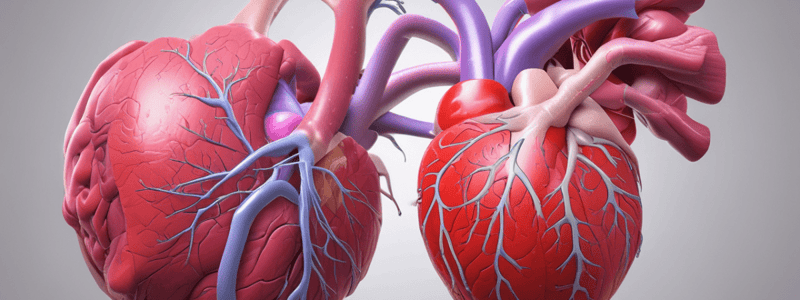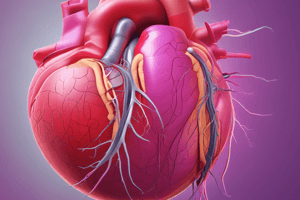Podcast
Questions and Answers
What is the most common risk factor for aortic dissection?
What is the most common risk factor for aortic dissection?
- Polyarteritis nodosa
- Marfan's syndrome
- Old age
- Hypertension (correct)
Which type of aneurysm is characterized by weakened arterial wall secondary to infection?
Which type of aneurysm is characterized by weakened arterial wall secondary to infection?
- Mycotic aneurysm (correct)
- Septic embolus aneurysm
- AAA aneurysm
- Berry aneurysm
Which condition is associated with aortic regurgitation as a clinical presentation?
Which condition is associated with aortic regurgitation as a clinical presentation?
- Kawasaki syndrome
- Ehlers-Danlos syndrome
- Marfan's syndrome (correct)
- Fibromuscular dysplasia
What is the hallmark feature of a true aneurysm?
What is the hallmark feature of a true aneurysm?
What is the main pathogenesis leading to the formation of syphilitic aneurysms?
What is the main pathogenesis leading to the formation of syphilitic aneurysms?
Which condition is characterized by fibrinous thickenings and adhesions in the pericardium?
Which condition is characterized by fibrinous thickenings and adhesions in the pericardium?
What is the main cause of abdominal aortic aneurysms?
What is the main cause of abdominal aortic aneurysms?
What histological feature is typically seen in aortic aneurysms due to cystic medial degeneration?
What histological feature is typically seen in aortic aneurysms due to cystic medial degeneration?
Which factor is implicated in the formation of amyloid in abnormal fibrillar form?
Which factor is implicated in the formation of amyloid in abnormal fibrillar form?
Which of the following is NOT a risk factor for abdominal aortic aneurysms?
Which of the following is NOT a risk factor for abdominal aortic aneurysms?
What process leads to local hypoxia, medial neovascularization, and inflammation in aortic aneurysms?
What process leads to local hypoxia, medial neovascularization, and inflammation in aortic aneurysms?
What is a common cause of intrarenal aneurysms?
What is a common cause of intrarenal aneurysms?
'Rupture associated with straining or orgasm' is a characteristic of which type of aneurysm?
'Rupture associated with straining or orgasm' is a characteristic of which type of aneurysm?
Which complication can occur due to distal embolization in patients with aneurysms?
Which complication can occur due to distal embolization in patients with aneurysms?
'Unequal upper limb pulses' as a clinical presentation is primarily seen in which condition?
'Unequal upper limb pulses' as a clinical presentation is primarily seen in which condition?
'Attenuation of aortic media' is a characteristic feature of which condition?
'Attenuation of aortic media' is a characteristic feature of which condition?
What is the common cause of left heart failure?
What is the common cause of left heart failure?
Which of the following is a characteristic of right ventricular failure morphology?
Which of the following is a characteristic of right ventricular failure morphology?
What is the main cause of dilated cardiomyopathy?
What is the main cause of dilated cardiomyopathy?
Which condition is known for mutations in genes encoding sacromeric proteins?
Which condition is known for mutations in genes encoding sacromeric proteins?
Which feature is typically seen in the microscopic morphology of dilated cardiomyopathy?
Which feature is typically seen in the microscopic morphology of dilated cardiomyopathy?
What is the hallmark pathogenesis of hypertrophic cardiomyopathy?
What is the hallmark pathogenesis of hypertrophic cardiomyopathy?
What is the most common motif found in amyloidosis?
What is the most common motif found in amyloidosis?
Which disease is NOT associated with amyloid like fibrils in the brain and heart?
Which disease is NOT associated with amyloid like fibrils in the brain and heart?
What type of amyloidosis is associated with plasma cell dyscrasias such as myeloma?
What type of amyloidosis is associated with plasma cell dyscrasias such as myeloma?
Which amyloidosis type is NOT correctly matched with its associated protein?
Which amyloidosis type is NOT correctly matched with its associated protein?
Which disease is NOT a form of transmissible spongiform encephalopathy?
Which disease is NOT a form of transmissible spongiform encephalopathy?
Which technique is NOT useful for definitive tissue diagnosis of amyloidosis?
Which technique is NOT useful for definitive tissue diagnosis of amyloidosis?
What characteristic finding can be observed on echocardiogram in patients with amyloidosis?
What characteristic finding can be observed on echocardiogram in patients with amyloidosis?
Which treatment option is NOT commonly used for systemic AL amyloidosis?
Which treatment option is NOT commonly used for systemic AL amyloidosis?
What is the primary cause of restrictive cardiomyopathy?
What is the primary cause of restrictive cardiomyopathy?
Which of the following is a common symptom of left heart failure?
Which of the following is a common symptom of left heart failure?
What is a characteristic microscopic finding in myocarditis?
What is a characteristic microscopic finding in myocarditis?
Which of the following is typically observed in pericarditis morphology?
Which of the following is typically observed in pericarditis morphology?
What is a common cause of acute pericarditis?
What is a common cause of acute pericarditis?
What distinguishes the gross morphology of restrictive cardiomyopathy from myocarditis?
What distinguishes the gross morphology of restrictive cardiomyopathy from myocarditis?
Which symptom is most likely associated with right heart failure?
Which symptom is most likely associated with right heart failure?
Which of the following diseases is associated with the abnormal accumulation of beta-amyloid proteins in the brain and heart?
Which of the following diseases is associated with the abnormal accumulation of beta-amyloid proteins in the brain and heart?
In the context of amyloidosis, which type is characterized by the deposition of transthyretin protein in various tissues?
In the context of amyloidosis, which type is characterized by the deposition of transthyretin protein in various tissues?
Which treatment option is commonly used to target prion diseases by inhibiting post-translational modifications of the prion protein?
Which treatment option is commonly used to target prion diseases by inhibiting post-translational modifications of the prion protein?
Which of the following is a key feature of the beta sheet structure predominant in amyloid fibrils?
Which of the following is a key feature of the beta sheet structure predominant in amyloid fibrils?
Which of the following conditions is NOT typically treated using immunosuppressive therapy for systemic involvement of amyloidosis?
Which of the following conditions is NOT typically treated using immunosuppressive therapy for systemic involvement of amyloidosis?
Which type of structure is most commonly associated with amyloidosis?
Which type of structure is most commonly associated with amyloidosis?
Which disease is characterized by amyloid-like fibrils in the brain and heart, and is heritable with trinucleotide repeats?
Which disease is characterized by amyloid-like fibrils in the brain and heart, and is heritable with trinucleotide repeats?
Which of the following is NOT a characteristic of prions?
Which of the following is NOT a characteristic of prions?
Which type of amyloidosis is associated with myeloma and plasma cell dyscrasias?
Which type of amyloidosis is associated with myeloma and plasma cell dyscrasias?
What is a possible treatment option for hereditary amyloidosis?
What is a possible treatment option for hereditary amyloidosis?
What is the most common motif found in amyloidosis?
What is the most common motif found in amyloidosis?
Which disease is NOT associated with amyloid like fibrils in the brain and heart?
Which disease is NOT associated with amyloid like fibrils in the brain and heart?
What treatment option is NOT commonly used for systemic AL amyloidosis?
What treatment option is NOT commonly used for systemic AL amyloidosis?
Which of the following is typically observed in pericarditis morphology?
Which of the following is typically observed in pericarditis morphology?
What is the hallmark pathogenesis of hypertrophic cardiomyopathy?
What is the hallmark pathogenesis of hypertrophic cardiomyopathy?
Flashcards are hidden until you start studying
Study Notes
Aneurysms
- Aneurysms are localized, abnormal, permanent dilations of a blood vessel.
- True aneurysms are surrounded by a complete vessel wall, with all layers affected.
- False aneurysms (pseudoaneurysms) are extravascular hematomas that communicate with the intravascular space.
- Types of aneurysms include:
- Saccular (berry) aneurysms
- Fusiform aneurysms (e.g. abdominal aortic aneurysm)
- Mycotic aneurysms (weakened arterial wall due to infection)
Aortic Dissection
- Most (>80%) aortic dissections develop without a pre-existing thoracic aortic aneurysm.
- Risk factors include hypertension, old age, atherosclerosis, Marfan's, Turner's, bicuspid aortic valve, Takayasu's arteritis, familial, and pregnancy.
- Histology: cystic medial degeneration, decreased vascular smooth muscle, mucoid deposition, elastin deficiency, and fragmentation.
Amyloidosis
- Amyloid is a protein in an abnormal fibrillar form, resistant to degradation.
- Amyloid formation relies on the polymerization of fibrils from an unstable intermediate state.
- Types of amyloid include:
- Systemic AL (Ig LC, lambda)
- Systemic AA (SAA, reactive systemic, chronic inflammatory)
- Abeta2M (Beta2-microglobulin, dialysis associated, chronic renal failure)
- Localized Abeta2 (APP, senile cerebral, Alzheimer's)
- ACal (Calcitonin, Endocrine, Medullary thyroid carcinoma)
- ATTR (Transthyretin, Familial amyloidotic neuropathies or systemic senile amyloidosis)
Cardiomyopathy, Myocarditis, and Pericarditis
- Causes of heart failure:
- Left ventricular failure: volume overload, pressure overload, loss of muscles, and restricted filling
- Right heart failure: left heart failure, lung disorders
- Morphology of left ventricular failure: gross depends on disease processes, LVH, and dilation; microscopy shows myocyte hypertrophy and interstitial fibrosis
- Morphology of right ventricular failure: heart varies with cause, typically RVH and dilation, possibly atrial dilation; liver shows nutmeg liver (chronic passive congestion), centrilobular necrosis, and cardiac cirrhosis; subcutaneous tissue shows pedal and sacral edema
Heart Failure
- Dilated cardiomyopathy/congestive heart failure: progressive cardiac dilation and contractile dysfunction, usually with concomitant hypertrophy
- Gross morphology: enlarged "flabby" heart due to dilation of all chambers
- Microscopic morphology: non-specific, may see hypertrophic myocytes
- Pathogenesis: secondary to ischemic heart disease, familial, post-myocarditis, toxins, hemochromatosis, sarcoidosis, and peripartum
Studying That Suits You
Use AI to generate personalized quizzes and flashcards to suit your learning preferences.




